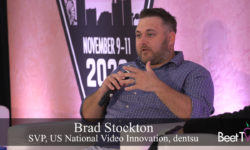SANTA MONICA — Little by little, as television has got connected to the internet, it has also been infused with some of the capabilities digital advertisers have enjoyed for years.
But are those capabilities really appropriate for the decades-old, largely-passive medium?
In this video interview with Beet.TV, Oscar Rondon, SVP of partnerships, MiQ, explains how he sees the optimum application of programmatic to television.
Four programmatic principles
Speaking at Beet Retreat Santa Monica to industry analyst Joanna O’Connell for Beet.TV, Rondon said he sees four principles of programmatic when it comes to TV:
- Audience based targeting: “TV now has more data sets than ever before. And so we have the ability to understand audiences at a deeper level than we did prior using just age, gender.”
- Frequency management: “Although it’s an area that’s still under development because there’s ad pod limitations with some of the ad servers.”
- Measurement: “We have capabilities that allow you to understand brand impact and brand lift all the way down to performance of specific channels and their contributions to your overall media buy.”
- Optimization: “We’ve been working a lot on trying to classify where we buy all of the CTV inventory and really do a better job of optimising across channels when you buy an omnichannel plan.”
Programmatic rising
EMarketer had forecast spend on connected TV (CTV) ad channels via programmatic methods would hit $14.3 billion in 2022).

That is actually the slowest growth in the method seen in years, but it is a channel that is maturing, as more ad buyers switch on to the new channels and new capabilities on offer.
Rondon’s MiQ offers programmatic campaign solutions including data analytics, creative build and trading insights, plus analytics and tech solutions.
Its customers include Subway, for which it says it increased incremental reach by 11.5% by identifying households exposed to the brand’s linear TV ad, leading to it being able to deliver a CTV ad to non-exposed households.
The work included harnessing Subway customers’ mobile location data to deliver further, digital ads to people who had both visited a Subway store and seen the TV ad.
Data for outcomes
Still, MiQ’s Rondon cautions buyers against expecting exactly the same as they found in digital display.
“One thing that I’d like to remind people is that there is such a thing as too much targeting on television,” he says.
“It’s still a brand-building medium and no-one can deny the power of sight, sound and motion.
“But I think where we are bridging the gap into the next generation of TV measurement is by leveraging unique data sets… Generally, by leveraging a data driven approach to finding audiences on television, you get better and therefore better outcomes.”
You are watching coverage of Beet Retreat Santa Monica 2022, presented by Ampersand, MiQ, Nielsen, PubMatic, T-Mobile Advertising Solutions and The Trade Desk. For more videos from the Beet Retreat, please visit this page.














































